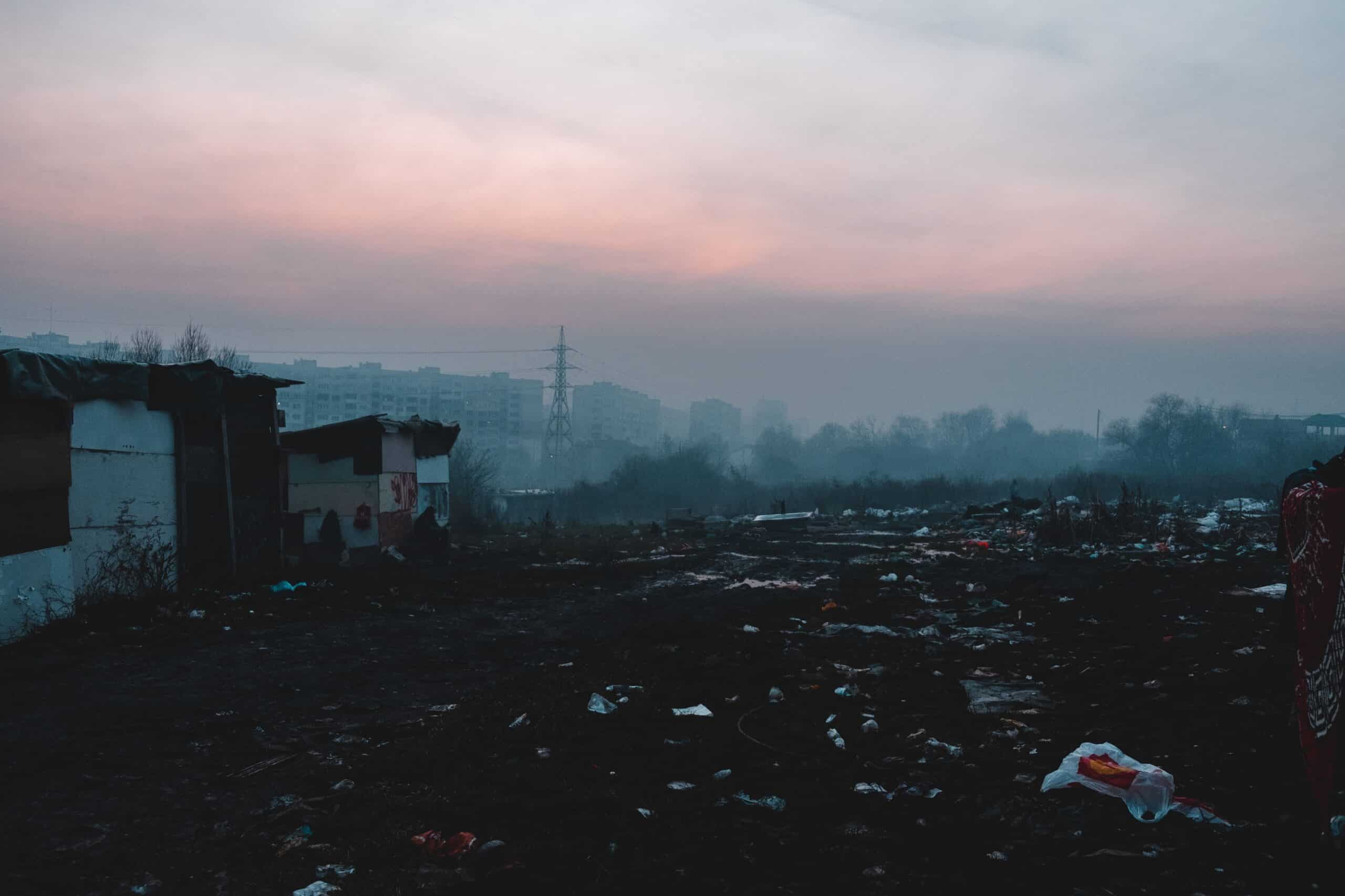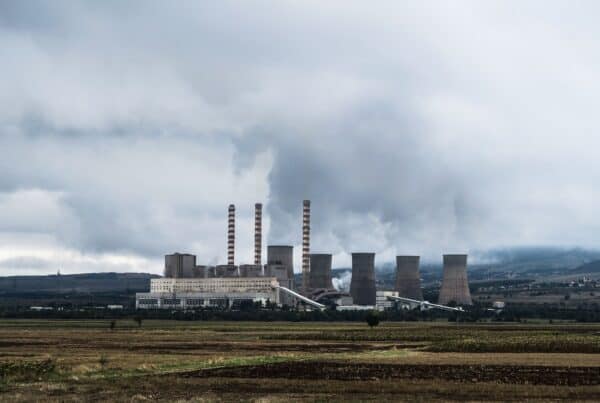Pollution, air quality and, more broadly, responses to climate change pose a challenge to the stability and security of the Balkan region. The environmental fragility of the region combined with critical socio-economic issues make it feared that the energy transition in the Western Balkans will not be a foregone conclusion. Faced with this scenario, in November 2020, the Green Agenda for the Western Balkans was launched, linked to the Economic and Investment Plan for the Western Balkans, which aims to support the Balkan countries in adopting mitigation measures for greenhouse gas emissions and air pollution.[1]
The problem of air pollution is a priority for the region: Balkan cities are among the most polluted in Europe.[2] It is also pointed out from many quarters that the adoption of measures in the environmental sphere cannot be unilateral: decision-making processes for responding to climate change – and especially adaptation solutions and practices – must negotiate between top-down institutional solutions, indications from science and bottom-up participatory paths.
In a complex social, economic and political context, environmental protection has recently been one of the main areas in which civil societies in the Western Balkans have managed to make their voices heard at the political level. The experiences that have arisen around the issue sometimes take on a local, sometimes regional and more rarely transnational dimension, potentially offering forms of collaboration and exchange between countries.
Pollution in Western Balkans
Air quality represents one of the greatest challenges to human health related to the increasing global push for urbanisation and industrialisation in many countries. The population of the Western Balkans is exposed to the most polluted air in Europe, often four times higher than the limits set by EU guidelines.[3] The human and financial costs on health are huge. As difficult as it is to produce or access reliable and comprehensive data on this, premature deaths due to emissions in the Western Balkans amounted to 1,250 in 2016 (including 570 in Serbia); cases of bronchitis due to coal plant emissions are reported to be 2,023 among children and 8,516 among adults, with a public health expenditure of €3.6 billion per year in the region.[4]
The sum of the different causes of pollution in the Western Balkans refers mainly to the use of low-quality solid fuels (wood and coal), the presence of old and obsolete industrial facilities and vehicles, the significant share of electricity generated in (coal-fired) thermal power plants, the contribution of emissions from large combustion plants and domestic heating. Although the Western Balkan countries monitor air quality in accordance with EU legislation, their monitoring systems are often inadequate.
Considering the challenges posed by climate change, one of the most complex issues for the Balkan region concerns the reform of the energy sector, which contributes two-thirds of greenhouse gas emissions.[5] While there is a pressing need to break free from fossil fuels and diversify energy sources, only Albania is in the forefront with respect to the use of hydro-electricity, while the other Western Balkan countries are still heavily reliant on coal.[6] In addition, coal-fired power plants in the region contribute to a high extent to the environmental pollution problem, emitting 20 times more sulphur dioxide and particulate matter than coal-fired power plants in the EU,[7] due to the presence of old and inefficient plants and thermal power plants, smelters, industries (such as cement, refining, mining and chemical).
Within the framework of IPA support, the countries of the region cooperate with the European Environment Agency (EEA) and are part of the European Environment Information and Observation Network (Eionet)[8] covering topics such as: a) Air pollution, transport and industrial pollution, b) Climate change impacts – vulnerability and adaptation, c) Climate change impacts – mitigation and energy.
However, only a few Balkan countries are able to produce and provide the data required by Eionet (North Macedonia and Serbia). As an example, the collection of data on particulate matter in the air (PM10) from stations varies between 12% coverage in Albania to 99.5% in North Macedonia.[9]
The difficulty in collecting and evaluating data is also evident in relation to historical reports (available since 1990) on emissions of various pollutants in the framework of the accession to the Convention on Transboundary Air Pollution (CLRTAP) (obligation stated in Article 8): Albania, Serbia and North Macedonia appear to be the most advanced countries, while Bosnia and Herzegovina lacks an inventory of pollutant emissions.[10]
On the basis of the analysis (data from Eionet – European Environment Information and Observation Network) carried out by the Joint Research Centre,[11] some graphs are reproduced below that clearly highlight the condition of general environmental fragility in the Balkan region.
The maps present the spatial dimension of the concentration of various pollutants, especially evident in some areas of Bosnia Herzegovina, Serbia, North Macedonia and Kosovo.
Figure 1
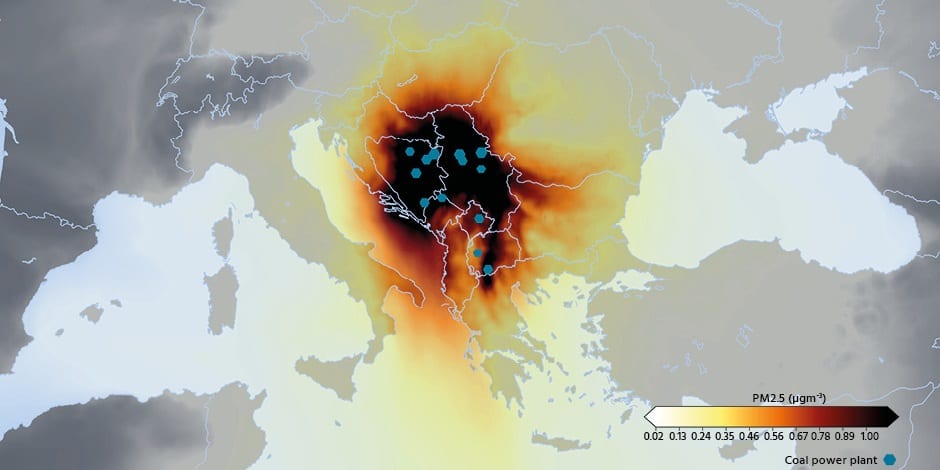
Source: Chronic coal pollution, 2019[12]
Figure 2
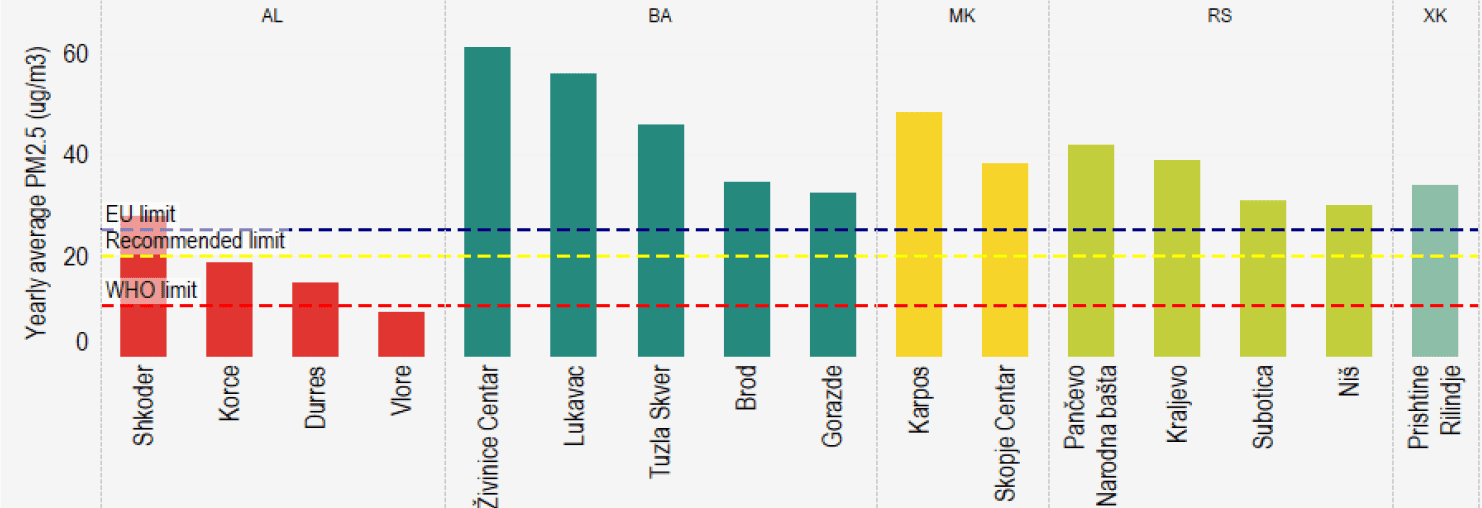
Source: European Commission, 2020[13]
Figure 3
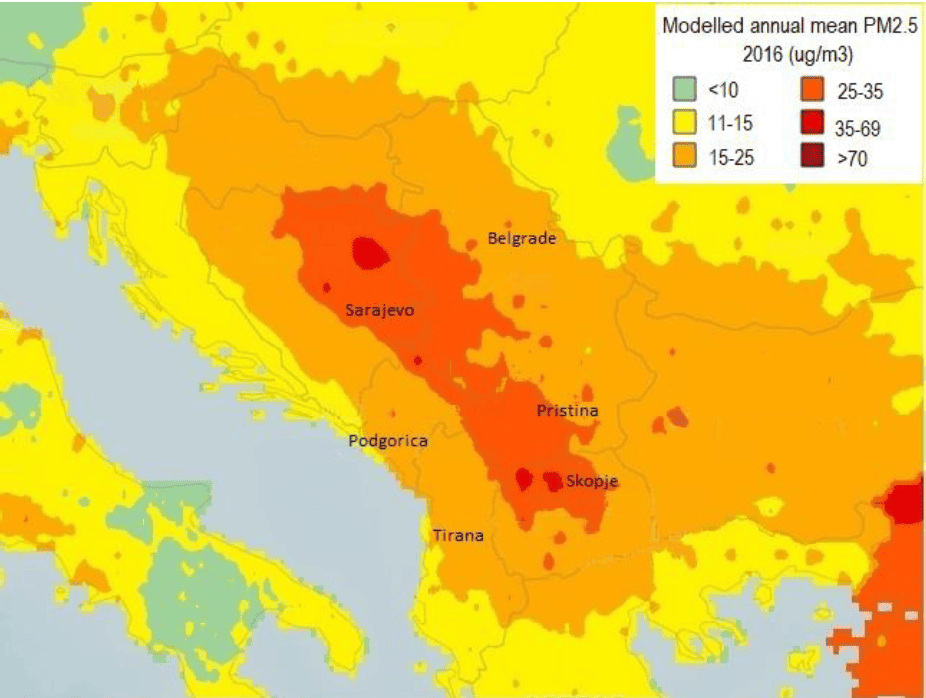
Source: World Health Organization, 2016
The presence of sixteen coal-fired plants in the Balkan region contributes to the large input of pollutants16 (e.g. sulphur dioxide, nitrogen oxide and PM10) as illustrated in the map opposite. In particular, emissions of sulphur dioxide and PM10 from plants in the region are respectively 10 and 16 times higher than the average emissions from plants in the EU.
Figure 4
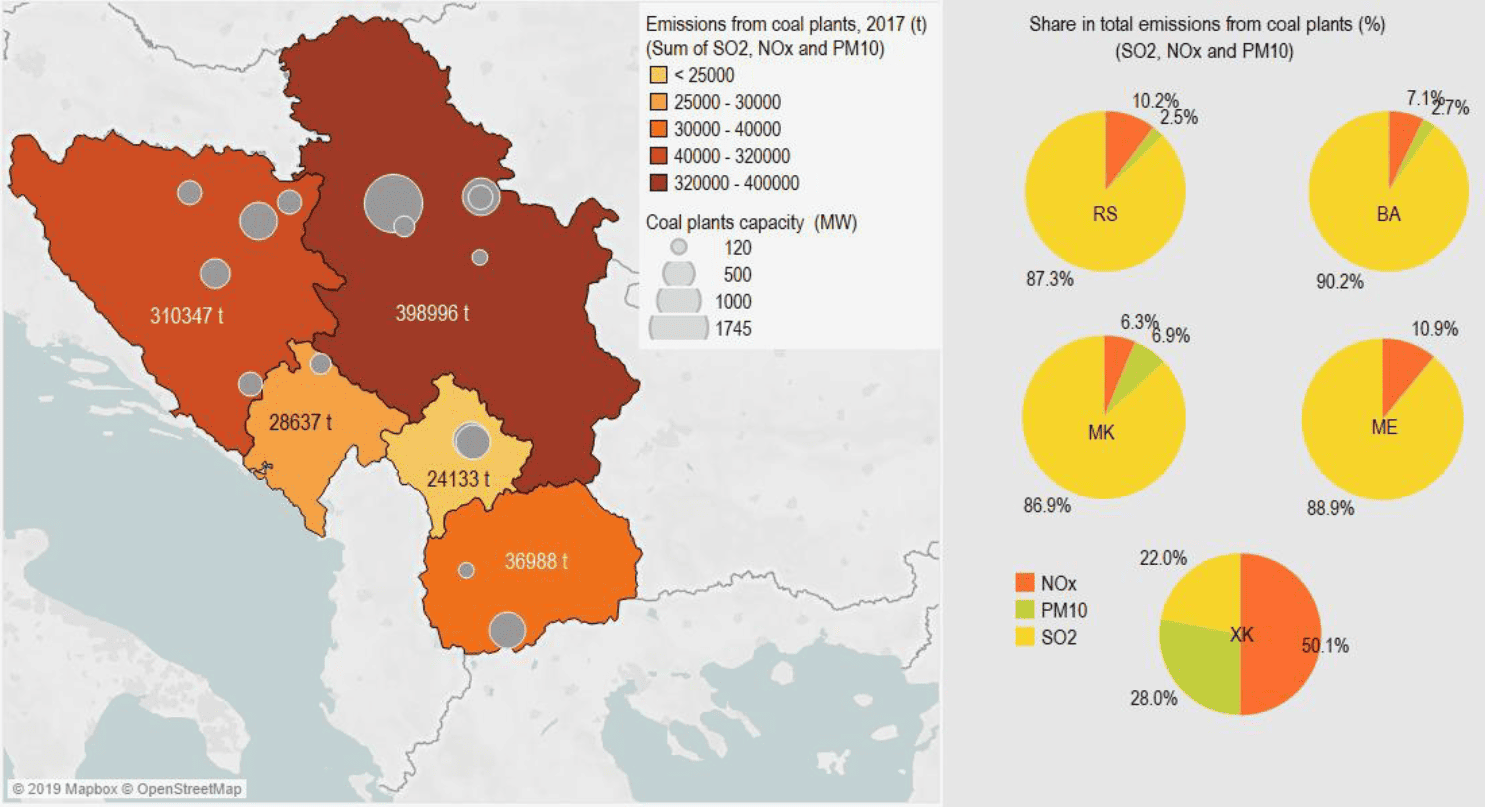
Source: Europe Beyond Coal, 2019[14]
In 2017, half of the sulphur dioxide emissions from coal-fired plants in the region were produced in Serbia; the contribution of PM10, on the other hand, is split between Serbia (36%), Bosnia and Herzegovina (30%) and Kosovo (24%). The high concentration of sulphur dioxide in Serbia and Bosnia and Herzegovina has been traced to emissions from thermal power plants using low-quality lignite with a high sulphur content, and from industrial activities in the energy, food production, chemical and mining sectors.
Based on a study of the 13 largest cities in the Western Balkans,[15] pollution of transboundary/international origin appears to be, on average, the main geographical source (40%) of PM2.5 in the cities analysed, followed by emissions from the metropolitan mobility area (19%) and emissions of national origin (16%). This means that regional emissions by geographic proximity contribute more to pollution and that city response measures themselves may not be the main solution. In contrast, national emissions are more influential in Serbia and Bosnia and Herzegovina and less so in Kosovo and Montenegro.
Figure 5
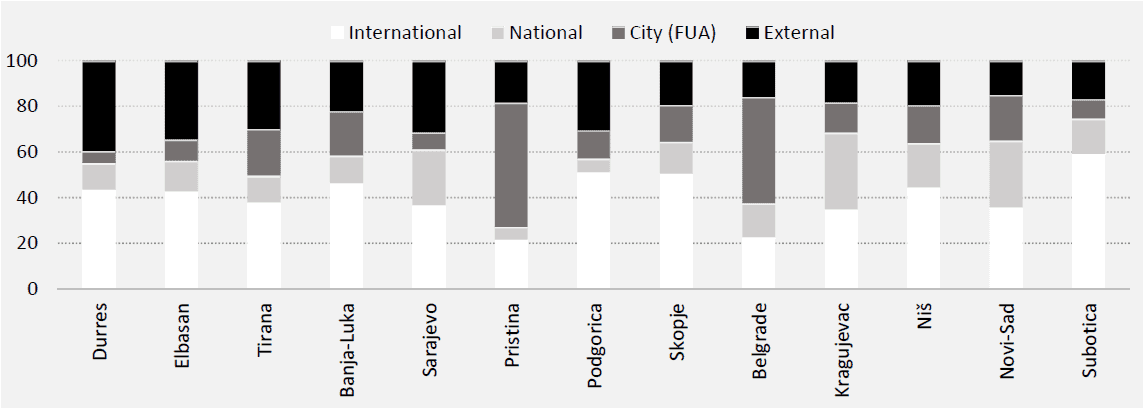
Source: European Commission, 2020[16] (percentage of impacted geographical areas to PM2.5)
The production activities that have the greatest influence on PM2.5 levels in the cities studied are energy (29%) (especially for cities in Serbia, Kosovo and Bosnia Herzegovina), residential heating (16%) (especially in Montenegro, in Podgorica, and in Serbia, in Niš) and agriculture (19%) (e.g. in Bosnia Herzegovina, in Banja Luka). The impact of industrial combustion and industrial processes is highest (11%) in North Macedonia (in Skopie) and Serbia (Subtica). By contrast, road traffic has a much lower impact overall (6%).
Figure 6
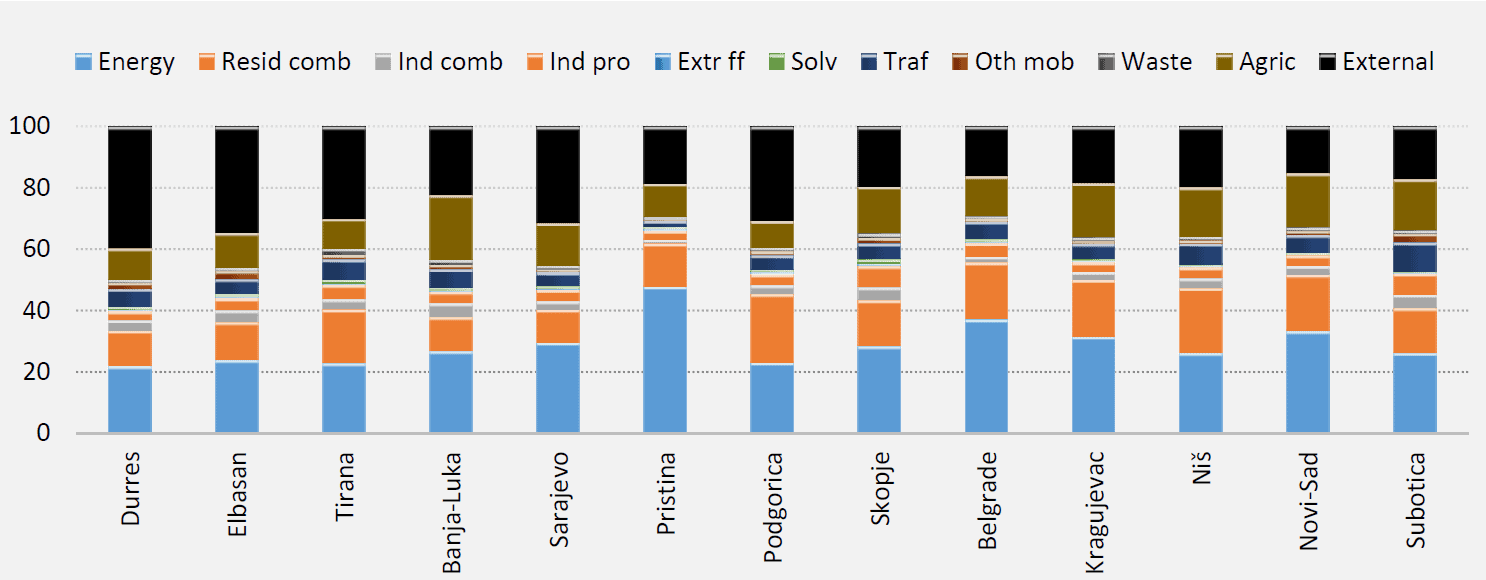
Source: European Commission, 2020[17] (Resid comb = residential combustion, Ind comb = combustion in Industry, Ind proc= industrial processes, Extr ff = extraction of fossil fuels, Oth mob = other mobile sources, Agric = agriculture.)
Based on the indications of the European Directive on Air Quality[18] that sets clear monitoring indicators, the countries of the Western Balkans are in a very difficult position due to their inability to foresee and implement urgent actions and policies at the local, national and transboundary levels that are able to decrease pollutant emissions from energy, transport, agriculture and industry sectors.
In the next parts we will analyse the matter of pollution within Wester Balkans public opinion and the European response to this emergency. You can find Part 2 here.
References
- https://joint-research-centre.ec.europa.eu/jrc-news-and-updates/eu-support-decarbonising-western-balkans-2020-11-10_en ↑
- https://balkaninsight.com/2017/02/14/balkan-cities-top-air-pollution-charts-02-14-2017/ ↑
- https://api.developmentaid.org/api/frontend/cms/file/2019/06/Air-Quality-and-Human-Health-Report_Case-of-Western-Balkans_preliminary_results.pdf ↑
- https://caneurope.org/report-eu-action-on-western-balkans-chronic-coal-pollution-is-a-unique-opportunity-to-improve-health-and-productivity/ ↑
- https://publications.jrc.ec.europa.eu/repository/handle/JRC118679 ↑
- https://www.clingendael.org/pub/2020/china-and-the-eu-in-the-western-balkans/ ↑
- https://publications.jrc.ec.europa.eu/repository/handle/JRC118679 ↑
- https://www.eionet.europa.eu/ ↑
- https://publications.jrc.ec.europa.eu/repository/handle/JRC118679 ↑
- https://publications.jrc.ec.europa.eu/repository/handle/JRC118679 ↑
- https://publications.jrc.ec.europa.eu/repository/handle/JRC118679 ↑
- https://caneurope.org/report-eu-action-on-western-balkans-chronic-coal-pollution-is-a-unique-opportunity-to-improve-health-and-productivity/ ↑
- https://publications.jrc.ec.europa.eu/repository/handle/JRC118679 ↑
- https://beyondfossilfuels.org/ ↑
- https://publications.jrc.ec.europa.eu/repository/handle/JRC118679 ↑
- https://publications.jrc.ec.europa.eu/repository/handle/JRC118679 ↑
- https://publications.jrc.ec.europa.eu/repository/handle/JRC118679 ↑
- https://eur-lex.europa.eu/legal-content/en/ALL/?uri=CELEX:32008L0050 ↑


